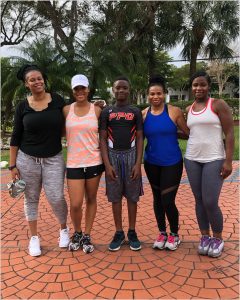As a fitness professional one of my greatest fears is for all of my client’s hard work and progress to go down the drain. These thoughts come to mind when a client utters the words “vacation”, “traveling”, or the dreaded (drumroll please) “holidays.”

Clients can default into a leisurely mode at any time and consume not-so-healthy meals counterproductive to their fitness goals. Yes, we all need a break but this is just my account as a professional of the stigma of the approaching holiday season. However, there are several ways to combat this, boost clientele performance and keep them on track.
Have Client Check-ins of Fitness Gains
Most races have check-ins/checkpoints, whether it’s Nascar racing: to maintain the vehicle, change oils and inspect tires or a marathon: to hand out beverages and gels to assure the participants are thoroughly hydrated.
In terms of a fitness journey, as professionals, we can have our clients check in with us a few days and weeks at a time leading up to, during, and even after the holidays or a vacation to make certain diet and workout regimens are being abided by sac closely as possible. How would a check in look like you ask:
- Trainer: “Thanksgiving is in in a week, I expect you log in your mileage of at least 4 miles before the aroma of turkey and pie invades your senses; I will check in with you first thing every morning as a reminder, got it?”
- Client: “Sure thing, coach. I will run a mile a day, I will follow each run with a few short sprints for extra measure, plus that will put me at a greater caloric deficit to squeeze in that piece of delicious pie * wink wink”
- Trainer: “……….I guess 😒”
This is an example of a checkin that can be applied to any facet of training to assuring that clients are either: fasting properly, eating the right foods, running the appropriate mileage, or doing the correct amount of workout sets. The goal is to create an atmosphere of open communication and accountability.

Compare Past and Current Client Performances
When clients seek your expertise it is almost always for the purpose of getting into shape, into better shape, getting stronger or getting faster; maybe all of the above. I record clients stats and performances earlier on in the training and fitness journey as a means of comparison of how much they have improved and in what time frame.
With the holidays surrounding us, there is no better time to put this into effect. As an example, I have some of my clients perform timed runs on a nearby street near my training facility that is a quarter mile in length. I give my clients the task of bettering their mark each time I have them perform a set.
This is really useful during the holidays as I would then be able to evaluate the effectiveness of my training. This lets me know how the fitness level and performance of my clients are affected by hectic holiday schedules, the holiday meals, missed training sessions, etc. Though it is simple, this measure of comparing the performances of your client (s) is a great tool in helping you be an accountable fitness professsional. It’s one that can maintain and generate results even throughout the holiday season.
Increase Workout Intensity and Volume
A higher caloric intake calls for more energy being burned, at least for the weight-loss client and those looking to stay lean during the holiday season or a vacation period. Sure, not all clients will binge eat when off routine but aside from this, the unknown can occur with all the chaos going on: the traveling, family demands, perhaps longer hours at work.
As fitness professionals, it is our job to compensate for these wedges thrown in the engine, per say. I find that increasing workout intensity and volume does the job, however, the amount of days is reduced due to the added demands on the body.
For your more seasoned and conditioned clients, this does the trick. Let’s say a client has been waiting weeks for well-deserved cheat days? That is ok because the week leading up to said cheat days I will do one or more of the following:
- Allow shorter rest periods: More carbohydrates are used as fuel.
- Increase the amount of reps: More fat is targeted for energy.
- Increase Cardiovascular Intensity: More carbohydrates are used as fuel during the working set and fat is used during the recovery phase.
- Increase the amount of weight per workout set: More muscle growth is stimulated.
Depending on the goal(s) of your client(s) you can adjust accordingly. The fat loss client will fare better with an increase of the number of repetitions per set, and the firming and toning client will fare better with an increase in weight per set.
Ideally, all clients can benefit from all these aspects of training though more emphasis is placed on one over the other in regards to that particular client’s fitness goals. Cheat day(s)? go right ahead!
Do you have other ways in which to help your clients make it through the holiday season staying on track with their goals?
Mr. Dassin is an NFPT certified trainer, NFPT author, and fitness model. A staunch humanitarian and intellectual, Stephen boasts over 15 years of experience in the areas of health and fitness. Stephen’s approach to personal training is methodical in nature; his methods take an interpersonal and scientific based view of the connections of the human mind and the human anatomy and it’s capabilities. His passion for fitness is unparalleled. His athletic background fueled his poise in becoming knowledgeable about nutrition as well. This added fuel to his desire to help others achieve their own individual goals in the area of fitness such as himself. Join Stephen on his journey, not just a fitness journey but the greatest journey of them all: Life.

